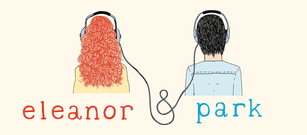| | I'm currently working on revising Kiss and Cry - yes, actually revising and not procrastinating at the moment, see previous post - and one of my problem areas with the novel is, well, too much crying. (I suppose I could simply add more kissing, but I wasn't intending to write a Fifty Shades knock-off for the YA set.) So what's my mission for this Technique Tuesday? As Donkey suggests in Shrek, "to try a little tenderness." (The chicks love that romantic crap!) No Princess Fiona here, but this week I examined another red-haired heroine: Eleanor. |

The novel opens with a short prologue that is actually a reprint of part of a scene that occurs much later in the book, where Park mourns the loss of Eleanor: “Standing behind him until he turned his head. Lying next to him just before he woke up. Making everyone else seem drabber and flatter and never good enough” (Rowell 1). Both tragic and tender, this scene sets the tone for the novel and provides the tenderness readers need to sustain them through Eleanor and Park's first meeting. A far cry from love at first sight, Park describes Eleanor using the words big, awkward, and mess. He compares her to a scarecrow. When he grudgingly allows her space on his seat, his first words to her are “Jesus-fuck...just sit down” (Rowell 9). Quite the heartthrob, and Eleanor's no better, silently thinking of Park as “that stupid Asian kid” (Rowell 12). Yet the prologue gives readers a sense that there is so much more to come, enough to sustain us through Chapter 6, when Eleanor finally thinks that Park at least has “cool shoes” (Rowell 24) and Park admits it feels “wrong to sit next to somebody every day and not talk to her” (Rowell 24).
Park and Eleanor slowly begin to interact with each other after Park realizes that Eleanor is reading his comics along with him on the bus and notices her eyes:
The new girl's eyes were darker than his mom's, really dark, almost like holes in her face. That made it sound bad, but it wasn't. It might even be the best thing about her. It kind of reminded Park of the way artists draw Jean Grey sometimes when she's using her telepathy, with her eyes all blacked out and alien. (Rowell 33-34)
Park still doesn't say anything to Eleanor, but he begins holding his comics to make it easier for her to read along with him, begins saving them only to read on the bus so she doesn't miss sections, even begins bringing comics to silently lend to her. These smallest gestures of kindness are amplified because Rowell surrounds them with the depiction of Eleanor's crappy home life, where her creepy stepfather has torn down even the sheet that was over the bathroom doorway, and the back story reveal of how Eleanor had to live with another family for months, which was “Terrible. Lonely. [But still b]etter than here” (Rowell 36).
Though Eleanor's home life is awful, Rowell doesn't make her a mere damsel in distress. She establishes Eleanor as intelligent and funny by interjecting scenes such as this one from an English class discussion:
[Shakespeare's] so obviously making fun of them...Romeo and Juliet are just two rich kids who've always gotten every little thing they want. And now, they think they want each other...They don't even know each other...It was 'Oh my God, he's so cute' at first sight. If Shakespeare wanted you to believe they were in love, he wouldn't tell you in almost the very first scene that Romeo was so hung up on Rosaline...It's Shakespeare making fun of love. (Rowell 44)
Wow. This girl is so smart, and I want to get to know her better.
So does Park. They begin really talking on the bus, with playful banter including witty one-liners from Eleanor such as “The least boring Batman story ever, huh? Does Batman raise both eyebrows?” (Rowell 60). Rowell writes, “They agreed about everything important and argued about everything else. And that was good, too, because whenever they argued, Eleanor could always crack Park up” (Rowell 64). These smart scenes diffuse nights at home where Eleanor comforts her siblings as her stepfather rages and attacks their mother in the next room, where Eleanor wakes up smelling like pee because her brother wet the bed and heads off for the bus with only the scent of her stepfather's bacon for breakfast.
Having established a tender, smart foundation for the blossoming romance between her two main characters, Rowell begins to include the first sexual scenes between Eleanor and Park. It doesn't take much. Combined with the tragedy that surrounds them, these scenes are amplified to the point where Rowell is able to sustain Eleanor and Park holding hands for the first time over two whole pages – and it's extremely hot. Not even beginning with actual hand-holding, Park first is simply holding the old silk scarf Eleanor had tied around her wrist. When he finally “slid the silk and his fingers into her open palm...Eleanor disintegrated” (Rowell 71). After, Eleanor wonders: “How could it be possible that there were that many nerve endings all in one place? And were they always there , or did they just flip on whenever they felt like it? Because, if they were always there, how did she manage to turn doorknobs without fainting?” (Rowell 73). Set against the tragic, the power of this scene is completely credible.
When a girl named Tina (who “went” with Park in sixth grade) and some other mean classmates dump Eleanor's clothes in the toilet during gym class, Park gets an accidental view of Eleanor in her tight gym suit. Rowell twists the tragic into sexy by making Park aroused: “How could he even look at her now? He wouldn't be able to. Not without stripping her down to her gym suit. Without thinking about that long white zipper” (Rowell 245). Park's next meeting with Eleanor results in six steamy pages of make-out bliss, at the end of which he confesses his gym suit turn-on. Rowell sneaks in a classic bit of comic relief with Eleanor's smart response: “Tina would be so pissed” (Rowell 254).
Through the inclusion of these and other tender, smart, and sexy scenes, Rowell sets readers up for the book's climax and conclusion. When Eleanor's stepfather finds out about Park, he is livid. Eleanor has to leave home again and we know she can never come back. Her last scenes with Park, as he drives her to her uncle's house hours away, are filled with the tragic and tender as we know they have to say good-bye. Unable to express her emotions for Park in words, Eleanor doesn't answer his letters. But after all these two have been through, this can't be the end and finally, on the last page, there's a postcard from Eleanor. “It filled his head with song lyrics...just three words long” (325). Rowell never says what those three words are, but we know they're the three that Eleanor never managed to tell Park. Just that one sentence and we know these star-crossed lovers get a happily ever after. Tender and tragic, smart and sad, sexy and stinging: Eleanor & Park is a combination as timeless as sweet and sour sauce that leaves readers wanting to come back for seconds.
Is your work in progress too sweet or too sour? I hope this provides some food for thought. Also, check back this weekend for the debut of a new blog feature: "What to Read this Weekend." I'll be sharing a pair of YA books each Friday that I'm reading for inspiration, annotated with why you might check them out to improve your own craft. Included with the first "What to Read this Weekend" post will be the promised quiz to guess Gabe's original name in Pairing Up to win a hardcover copy of Something Real, fellow VCFA student Heather Demetrios's fantastic debut novel.
Works Cited:
Rowell, Rainbow. Eleanor & Park. New York: St. Martin's Griffin, 2013. Print.

 RSS Feed
RSS Feed